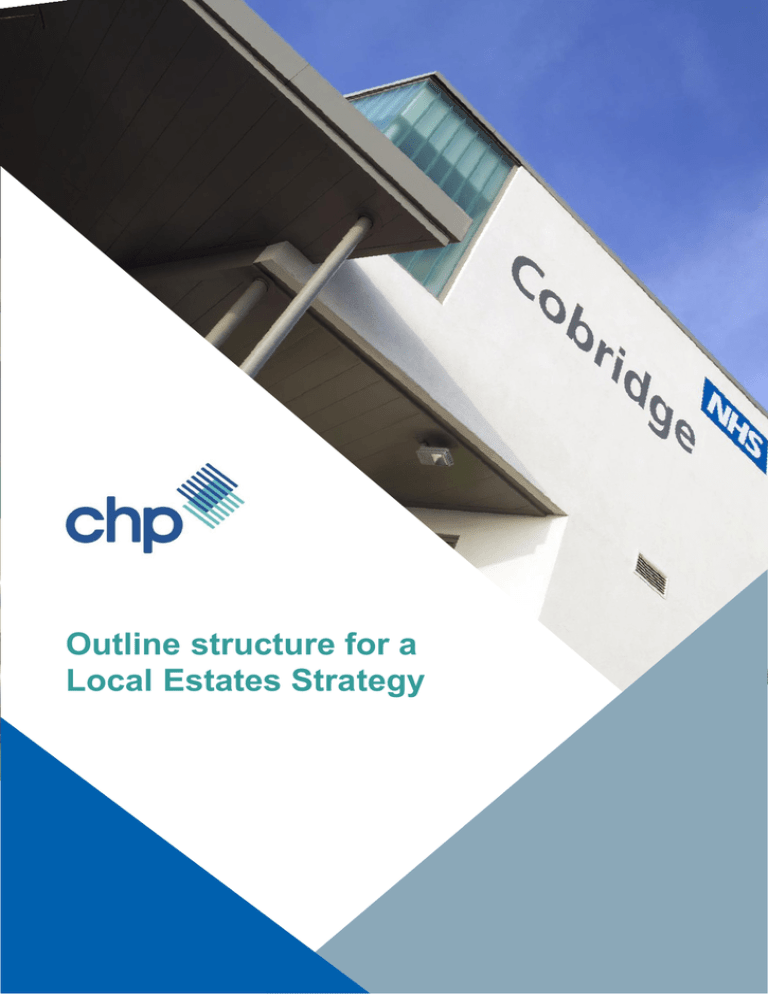Outline structure for a Local Estates Strategy
advertisement

Outline structure for a Local Estates Strategy Page 1 of 7 What’s needed in a Local Estates Strategy? A Local Estates Strategy helps health economies to turn properties into flexible assets that can support changing services. It has an important role to play in enabling change, delivering savings, reducing running costs and ensuring that all investment is properly targeted. There is no absolute template for Local Estates Strategy. Every plan is different, depending on local circumstances and the complexion of the estate. However, a strategy should be able to deliver an estate which will be responsive to change, taking account of demographic trends, increasing specialisation, integration of health and social care, provision of care closer to home, technological advances and new ways of working. 1. Executive Summary The Executive Summary should begin with an introduction explaining what the plan will cover. It should then overview the existing estate and examine how service developments, based on the Commissioning Plan, as well as associated estate needs, are driving the case for change. A vision for the estate to meet these health and social care requirements should then be laid out briefly. Any gaps in estate between what exists now and what is needed are identified. The Estates Options for Change are then identified. From these is evidenced some preferred opportunities, with the services benefits demonstrated and the financial impact at a system level of any proposed changes. Finally, this section summarises delivery of the vision with, first, the immediate priorities in terms of particular sites, including opportunities for investment or disinvestment that would be implemented as ‘no regrets moves’ within two years. Ideally, a longer-term, five year work programme is also specified. An implementation schedule explains how the plan’s conclusions and recommendations should be actioned. 2. Introduction Objectives and scope The introduction explains the purpose of the exercise and the approach used to develop the Local Estates Strategy, including how the local health economy has been brought together to understand service priorities, the estate that is already available and how it can be changed to deliver those services. This section should detail the scope of the plan. In terms of property, this is the main NHS estate (Acute, community, primary care and administrative facilities), plus accommodation supporting social care functions with close links to health should be included, such as domiciliary care, clinics and local authority residential care. It does not include private sector estate such as residential homes or non-NHS facilities providing services under contract. Additionally, the main stakeholders should be detailed, including Clinical Commissioning Groups, NHS Trusts, Local Authorities, NHS Property Services, NHS England, Community Health Partnerships as well as local GPs and any non-NHS organisations providing services from NHS estate. Page 2 of 7 Methodology The methodology should highlight how regular, structured conversations over several months have generated fresh thinking among local leaders to achieve the best outcomes for patients. It should cover the series of steps that have gone into creating the plan, leading to an evaluated, well justified set of options and a schedule for implementation. 3. The Current Estate Estate summary This section reviews the current estate delivering services in the area. It should focus attention on those sites whose cost and size make them central to any analysis. Include the proportions of the estate that are dedicated to certain functions (acute, community, primary, administration etc.); that are held by particular owners (Trusts, NHS Property Services, CHP, local authority etc); and that are part of major sites. Site reviews: Asset condition, suitability, utilisation and occupation, financial summary A review, no longer than a page, of each major site should be included in the Appendix. The main acute site can have a longer review. These reviews should involve a brief description; main services delivered from the site; building condition; current utilisation; forecasts of backlog maintenance; any significant changes either already agreed or proposed; suitability for long term retention; re-development potential; current view as to likely future (usage and configuration). This review mustn’t prejudge the strategic estates planning process but should capture honestly the strengths and weaknesses of each site. It should draw on the data collected, including current estates strategies. Supporting information, such as plans, photographs or detailed financial breakdowns, can be appended. Data might come from many sources including: SHAPE (Strategic Health Asset Planning and Evaluation application); Commissioning Strategies and Plans; Provider Strategies and Plans including Estates Strategies and Business Plans; Public Health data; Demographic data including Planning and GP practice data. Key Estates Issues: Performance analysis and surplus assets Next, a short high level summary report should be created that sets out themes, such as: Existing space that is (or will shortly be) no longer fit for the delivery of modern health care services and/or has significant maintenance/condition challenges. Void space in long-term core buildings. Modern high quality space that is under-occupied. Bookable space that is not well used. Occupied space that is often badly utilised. Standard hours of working and potential for 7-day opening. Modern space filled with administrative, rather than clinical, activity. Incompatible ICT systems preventing joint use of clinical space. The section should summarise all the key issues that the Local Estates Strategy must tackle with respect to specific sites. Page 3 of 7 4. Vision for the Estate Drivers for change: socio-economic/service/estate/external Summarise, perhaps in tabular form, the main drivers for change to explain, in high level terms, the chief differences between what is happening now and what is expected to happen in the projected model of service delivery. These drivers might include changes in population, new housing, shifts in disease profiles as well as innovations in medical procedures and technology, plus new models of care, all of which may have important impacts on service models and therefore estate needs. Commissioning Objectives and overarching principles Identifying the estate you need is probably the most important stage of the process because it aims to define the shape of services in the future that the estate must support. This section should show a clear understanding of where services are currently delivered across the system, and how some are co-located, within the different localities and various care settings. It can be useful to collect the information in tabular form and then summarise the existing pattern of delivery in a schematic diagram. Then set out a cohesive strategic direction for future service delivery for the locality, presenting the outcome in a similar manner to that used to describe the current service delivery model. Finally, combine this future service delivery model with high-level schedules of accommodation to set out a vision for the estate of the future. This sketch should build in the following facilities: Community hospitals; Community/locality hubs; Community mental health facilities; Health centres/clinics; GP surgeries; Team bases and support facilities; Administrative office space. It is also important to assess the impact of these changes on the main acute site serving the local area. 5. Gap Analysis In this section, identify the discrepancies between the present and future estate and set out the key priorities for change. Some buildings may be fit for purpose and be needed as core estate in the future. Investment may be required to improve the flexibility of some buildings for services. There may also be facilities that are not needed anymore as technology changes and more people are treated at home. So some facilities have a long-term future, some are clearly no longer needed and some estate requires investment so it is flexible enough to deliver the health vision. The plan can divide existing estate into three broad categories: Suitable for long term use and able to meet future requirements with only routine adaption. These are the core sites, part of the ‘estate of the future’. Suitable for long term use, but likely to meet future requirements only with major investment and change. Unlikely to be suitable long term. These buildings could, potentially, be disposed of, or disinvested from. In addition, the plan should clarify where there are gaps with no current estate capability to meet future service requirements. At this point, the plan has established the overall strategic direction of the estate: what needs to change over time – and the relative urgency - to meet future service requirements. Page 4 of 7 6. Estates Options for Change Summary of estates options Next, the plan summarises the estate options, the key priority areas where the estate will need to change over the next five years. These might include: Substantially consolidating activity on a site to reduce operating costs and release land for disposal and capital for reinvestment. Closing a site and moving activity elsewhere, where there is spare capacity, to reduce operating costs and free up capital for reinvestment. Replacing a number of poor quality buildings, that are no longer fit for purpose, with a new facility that can support a wider range of services. Providing a new facility in a particular locality to meet changed models of care and service delivery. Option evaluation criteria The plan should include a high level evaluation of the options against both operational and financial criteria. These should be devised locally, but are likely to include the relative impact of each option on clinical services and patient care; compatibility with commissioning and provider strategic plans; ease of implementation; acceptability to stakeholders; strategic flexibility and the impact on both revenue and capital budgets. Option Evaluation Finally, the options need to be evaluated. It is too early to undertake a detailed five case business case, but high level analysis of each option against the evaluation criteria should be completed to confirm those initial options that should be progressed as part of the Local Estates Strategy. 7. Local Estates Strategy Outline of preferred options The next stage is the preparation of the Local Estates Strategy. This should include setting out the ‘No Regrets’ moves that have wide support and should be prioritised over the next two years. The Strategy should also identify plans for a longer five year period, where further analysis will probably be required. This option appraisal process offers a more detailed picture of how to deliver the key estate changes. Combining these two outputs – overall estate strategy and means of delivery creates the essential elements of a high level estate development plan for the next five years. The level of detail that is possible may differ for each local area: more comprehensive in some cases and amounting to a long term development plan for their estate. In other instances, the plan may just have set out a direction of travel, focussed more on specific opportunities and addressing immediate concerns. Financial analysis A single summary report should estimate the financial impact of the changes to the estate over the next five years. It should include details on: efficiency savings and savings targets; capital funding requirement and the investment pipeline envisaged; any disposals in the period and projected capital receipts (if any). Page 5 of 7 Service benefit The estates development plan should include analysis of the patient and service benefits that it provides as well as the impact in terms of efficiencies and other gains. 8. Implementation Planning Implementation priorities The Local Estates Strategy will be the agreed view of the Local Estates Forum which should then seek endorsement of the plan from individual Boards and typically the corporate leadership of the local health and social care system. If the Local Estates Forum cannot agree a particular element of the proposed plan, issues should be referred upwards to help resolve these disagreements. The corporate leadership group will also approve the mandate and arrangements to proceed to implementation. The plans should set out the implementation priorities. Programme plan and milestones The plan should articulate the implementation work streams, covering both the “no regrets moves,” and issues requiring further analysis. It details actions for what the implementation groups will be doing along with delivery timescales and a series of milestones, as well as identifying resources to support the changes. Managing constraints and risk With so many parties involved and so many potentially competing views, it is easy for the process to become stuck. The plan should identify enablers of change. For example, the National SEP Steering Committee can help unblock constraints, if it can. The local Strategic Estates Adviser (SEA) should help organisations work collaboratively rather than simply self-interestedly, so that the system operates as well as possible for patients. The plan should also include a full assessment of risks and mitigating factors. One possible outline structure for a Local Estates Strategy is shown in Appendix 1. July 2015 Page 6 of 7 Appendix 1: Illustrative Local Estates Strategy Outline Structure 1. Executive Summary a. Introduction b. Overview of Existing Estate c. Vision for the Estate d. Estates Gap Analysis e. Options for Change f. The Local Estates Strategy g. Implementation Planning 2. Introduction a. Objectives and scope b. Methodology 3. The Current Estate a. Estate summary b. Site reviews c. Key estates issues 4. Our Vision for the Estate a. Drivers for change b. Commissioning objectives c. Our Vision 5. Gap Analysis 6. Estates Options for Change a. Summary of estates options b. Evaluation process and criteria c. Option evaluation 7. Local Estate Strategy a. Outline of preferred options b. Financial analysis c. Service benefits 8. Implementation Planning a. Implementation priorities b. Programme plan and milestones c. Managing constraints and risk. Page 7 of 7





